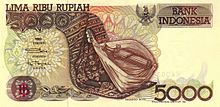This article needs additional citations for verification. (April 2021) |
 Man playing Sasando | |
| Classification | String Instruments |
|---|---|
| Inventor(s) | Rotenese people |
| Developed | Indonesia |
| Related instruments | |
| Indonesian Traditional Instruments | |

The sasando, also called sasandu from Sandu or Sanu,[1] is a tube zither, a harp-like traditional music string instrument native to Rote Island of East Nusa Tenggara, Indonesia.
The name sasando is derived from the Rote dialect word ”sasandu”, which means "vibrating" or "sounded instrument". It is believed that the sasando had already been known to the Rote people since the 7th century.[2]
The main part of the sasando is a bamboo tube that serves as the frame of the instrument. Surrounding the tube are several wooden pieces serving as wedges where the strings are stretched from the top to the bottom. The function of the wedges is to hold the strings higher than the tube surface as well as to produce various length of strings to create different musical notations. The stringed bamboo tube is surrounded by a bag-like fan of dried lontar or palmyra leaves (Borassus flabellifer), which functions as the resonator of the instrument.[3] The sasando is played with both hands reaching into the stings of the bamboo tube through opening on the front. The player's fingers then pluck the strings in a fashion similar to playing a harp or kacapi.
The sasando can have 28 (sasando engkel) or 56 strings (double strings).
- ^ "Tube Zither (Sesando or Sasandu), late 19th century". The Metropolitan Museum of Art. 2013. Archived from the original on 2011-01-18. Retrieved December 29, 2013.
- ^ ASEAN (2020-08-08). "What is Sasando? Where did it come from? How to play it?". indonesiar - Indonesia negeriku, orangnya lucu-lucu. Retrieved 2021-04-26.
- ^ [1] [dead link]